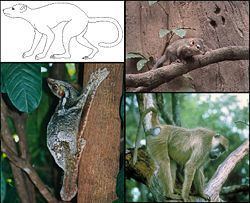Scientific name Euarchonta | Phylum Chordata Grandorder Euarchonta | |
 | ||
Lower classifications Primate, Treeshrew, Gorilla, Great apes, Humans | ||
The Euarchonta are a proposed grandorder of mammals containing four orders: the Dermoptera or colugos, the Scandentia or treeshrews, the extinct Plesiadapiformes, and the Primates.
The term "Euarchonta" (meaning "true ancestors") first appeared in the general scientific literature in 1999, when molecular evidence suggested that the morphology-based Archonta should be trimmed down to exclude Chiroptera. Major DNA sequence analyses of predominantly nuclear sequences (Murphy et al., 2001) support the Euarchonta hypothesis, while a major study investigating mitochondrial sequences supports a different tree topology (Arnason et al., 2002). A study investigating retrotransposon presence/absence data has claimed strong support for Euarchonta (Kriegs et al., 2007). Some interpretations of the molecular data link Primates and Dermoptera in a clade (mirorder) known as Primatomorpha, which is the sister of Scandentia. In some, the Dermoptera are a member of the primates rather than a sister group. Other interpretations link the Dermoptera and Scandentia together in a group called Sundatheria as the sister group of the primates.
Euarchonta and Glires together form the Euarchontoglires, one of the four Eutherian clades.
The current hypothesis, based on molecular clock evidence, suggests that the Euarchonta arose in the Cretaceous period, about 88 million years ago, and diverged 86.2 million years ago into the groups of tree shrews and Primatomorpha. The latter diverged prior to 79.6 million years into the orders of Primates and Dermoptera. The earliest fossil species often ascribed to Euarchonta (Purgatorius coracis) dates to the early Paleocene, 65 million years ago, but it appears to have been a non-placental eutherian. Although it is known that Scandentia is one of the most basal Euarchontoglire clades, the exact phylogenetic position is not yet considered resolved, and it may be a sister of Glires, Primatomorpha or Dermoptera or to all other Euarchontoglires. Recent studies place Scandentia as sister of the Glires, invalidating Euarchonta.
